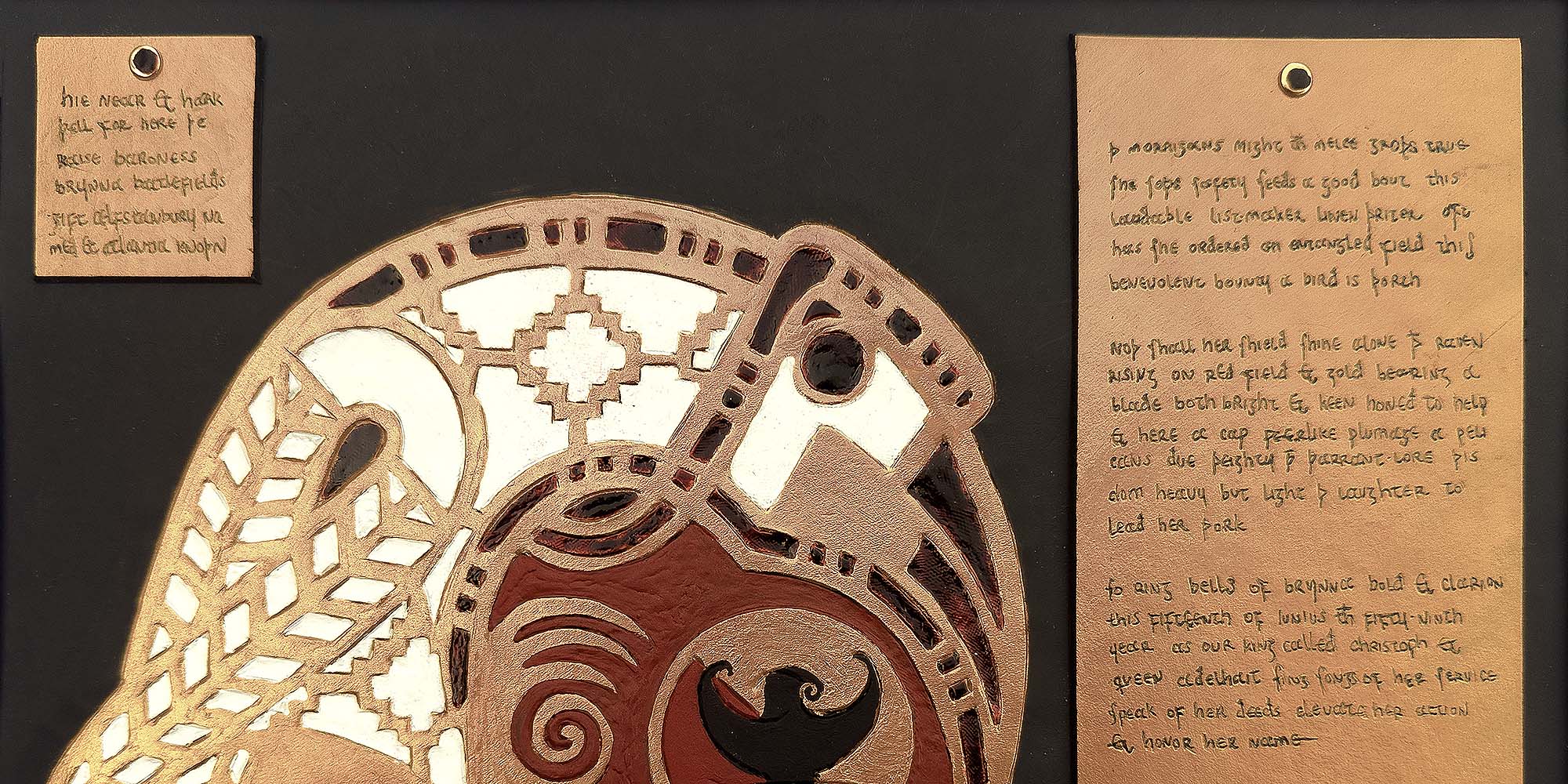It was my great honor to create this scroll on the occasion of Baroness Brynna of Ælfstanbury’s elevation to the Order of the Pelican. Words and scroll by me.
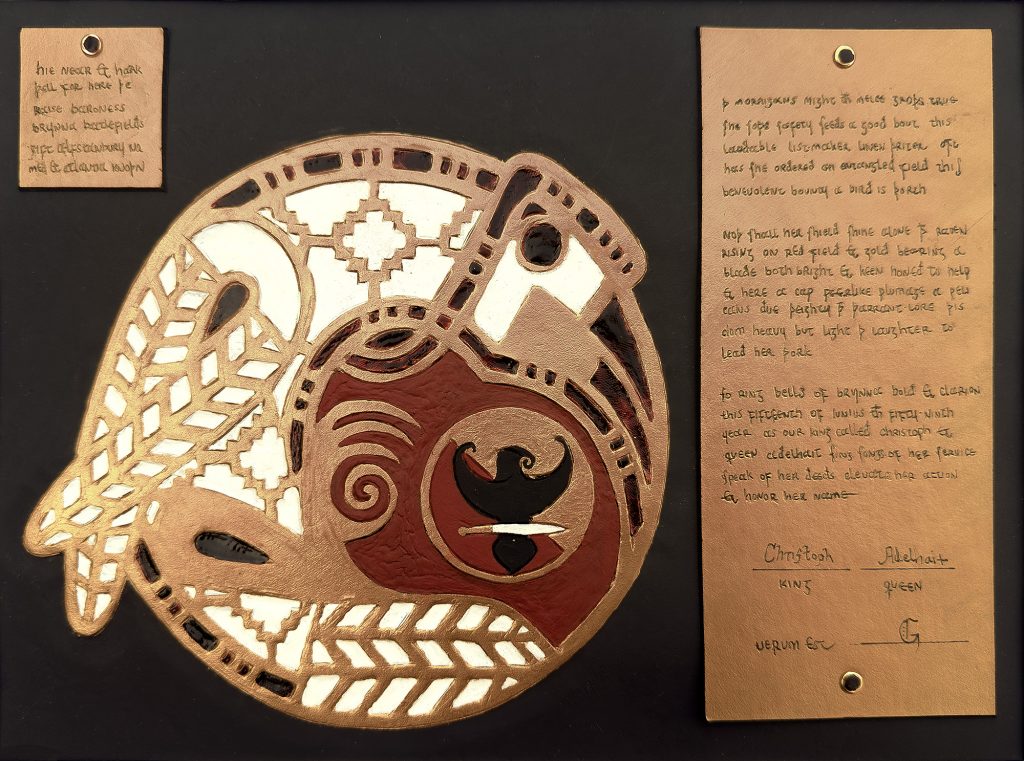
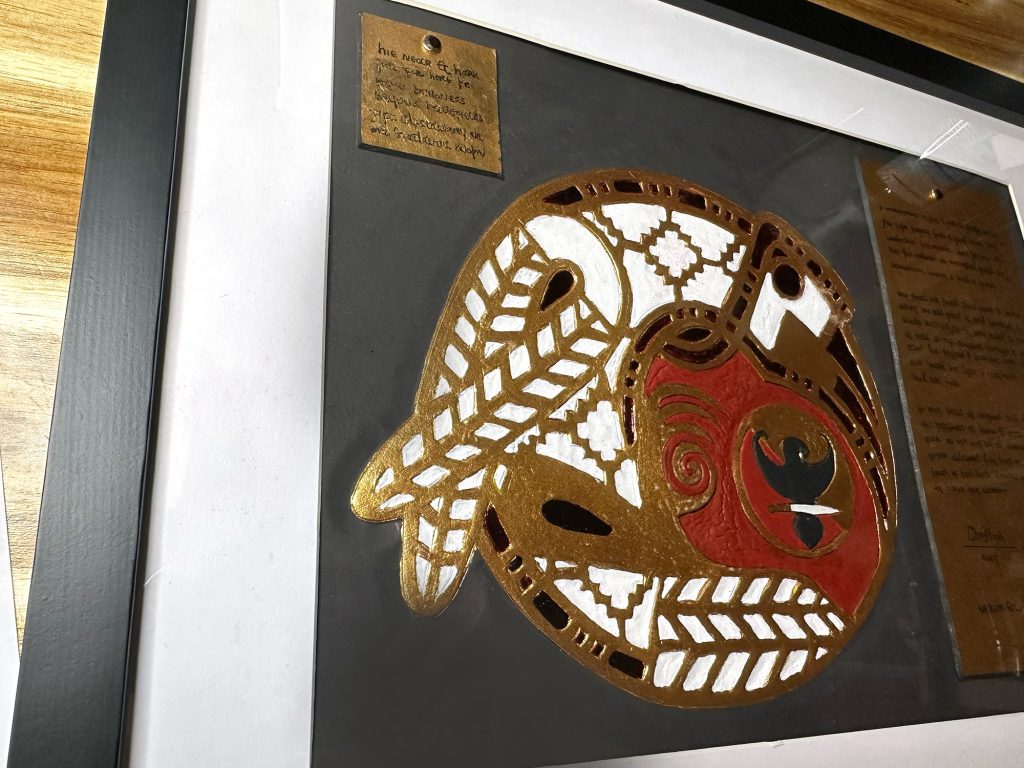
A GIFT
Whatever else, a scroll is fundamentally a gift.
I haven’t had the pleasure of meeting Brynna, but I wanted the scroll to be specifically for her, so I gathered information. I was told that she particularly likes the Early English time period. I was told she likes the Morrigan (which matched well with the raven in her heraldry). I was also told she might better appreciate a scroll in a standard shallow frame (as opposed to an object, or a shadow box). It’s helpful to have these sorts of guardrails on a project; sometimes an open landscape is harder, because with no restriction you have to choose from a set of everything. In my experience, constraints can help drive creativity, since they clear space for problem solving.
As in this case. Scrolls for places and times without a strong book culture are always interesting, because they can’t simply be manuscript pages. Usually these places and times are conjured better with some manner of material culture, as with this scroll’s Migration Period/Early 7th century English. But the result had to be flat, so I had to make choices about how to portray the art within that constraint.
In past situations like this I’ve found it useful to create what I call a “museum scroll”. Artifacts are arranged within the frame to echo the storytelling of a museum display, as opposed to emulating an artifact in its entirety (as in the usual scroll), and a cohesive piece comes from the careful selection of items and style. In this museum scroll, the art—whether it be brooch or other metalwork—would fill the lower left of the frame, and the words would be carried on separate artifacts surrounding it.
It’s just as well that I’m not a master goldsmith. If I were to capture the specific art-feel of Early England in a flat form, I would have to transfigure the art into a new medium.
remediation, again
I’ve spoken before about remediation.
I won’t completely rehash that discussion, but previously I explored the affordances and benefits of bringing three-dimensional gold Scythian design to a flatter champlevé enamel brooch. I discussed the ways in which our work in the SCA both inhabits the definition of remediation set forth by Bolter and Grusin, but also the ways in which our work in the SCA takes it further.
Quoting my previous post:
“In their 2000 book “Remediation: Understanding New Media”, Bolter and Grusin argue that the term remediation describes “the way in which one medium is seen by our culture as reforming or improving upon another”1. Rather than simply an extension of the word “remedy”—as in, bringing remedial studients up to scratch, or remediating a damaged ecosystem—their definition is one of medium as well as improvement. The DVD improved on the cassette tape; the MP3 improved on the DVD. Their remediation describes this process.”
This particular scroll remediates Migration Era English goldwork into a tooled and sculpted leather form. In this situation, the improvement is its alignment with the specific needs of the piece, which would not be served by a replication in gold and at jewelry scale. The translation improves the result through my adequate leatherworking skills and redresses my inadequate (read: missing) goldsmith skills, and it’s an improvement because the increase in scale increases the visibility at court or on a wall.
This scroll also remediates Migration Era English goldwork in its intent. Again, as discussed here, regardless what we know of our forerunners’ goals, doubtless they weren’t creating awards for the SCA. The means that no matter what we produce or how we produce it, there will always be a disconnect between our actions and the actions of the original creators. In my experience, this leaves us space to direct our creation more accurately for the SCA goals without feeling more beholden than necessary to the art of the past. A scroll is, after all, a gift. Not a reproduction.
ACCURATELY ABSTRACTED
By definition, the Germanic Animal Style art of the Migration Period is abstract. The degree and manner of abstraction have been typologically sorted (first by Bernhard Salin in the early 20th century2), and for our current 7th century purposes we’ll be talking about his Style II, which is associated with the metalwork of the second half of the 6th century through early 7th. In contrast to the animals-in-blender of the former style (his Style I), this Germanic Polychrome style3 involved whole beasts twisted and abstracted, often elongated, sometimes interlaced, a visual puzzle to compliment the Early English taste for riddles. Animals are almost always in profile, and sometimes it’s not even clear which class of animal is pictured, let alone number or species. There are times when it’s not even obvious an animal is being pictured—that it’s not an entangled collection of shapes.
The heraldic pelican from which this award gets its name, on the other hand, is anything but abstract. While the art of the High Middle Ages is not known for its true realism, it is nevertheless figurative. Though flawed, perspective still comes into play. Animals are portrayed from the front, in profile, in plan, and however the creator felt would best communicate their goal. When these illuminators or carvers or metalworkers created an animal, generally they wanted you to know what it was. In fact, because the primary goal of heraldry is to be recognizable in brief viewings and at distance, its goal is the antithesis of the riddling obfuscation of a lot of Early English art.
Which is to say: the later heraldic pelican bears certain characteristic features which would look quite out of place if pulled into the early-7th-century English art style of this scroll.
And arguably, one of the goals of a scroll is to be internally and externally consistent, even as it records the achievement, provides a gift, and makes the awardee feel seen. So given the charge to create an Early English scroll, first I had to create a pelican that suited the style.
But to our good fortune, birds abound in Early English goldwork. It was no struggle at all to find references that could become my pelican.
In fact, I found everything I needed in just a few artifacts.
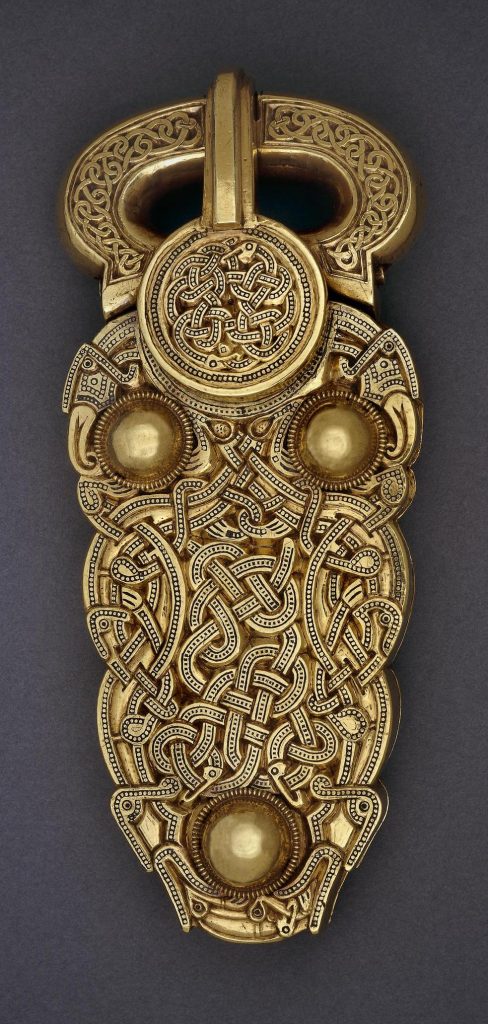
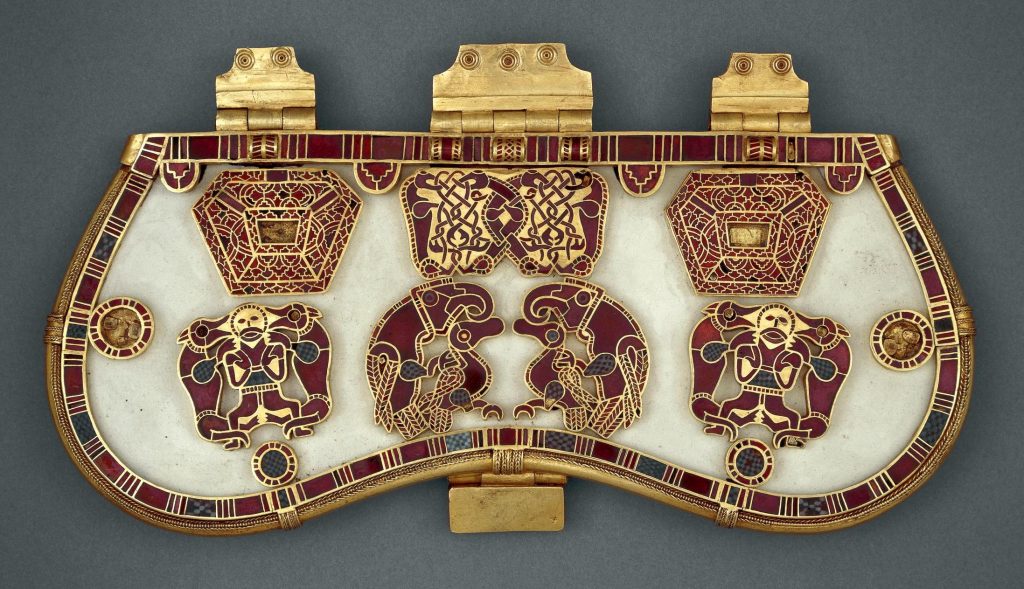
birbs
My primary reference, a bird from the Sutton Hoo purse lid4, provided me the curved figure, the wings, the tail feather structure, and the border detailing (which was echoed both in the bird and the overall lid). I altered the beak to make it slightly more reminiscent of a pelican, including blood at its tip for the heraldic nod.
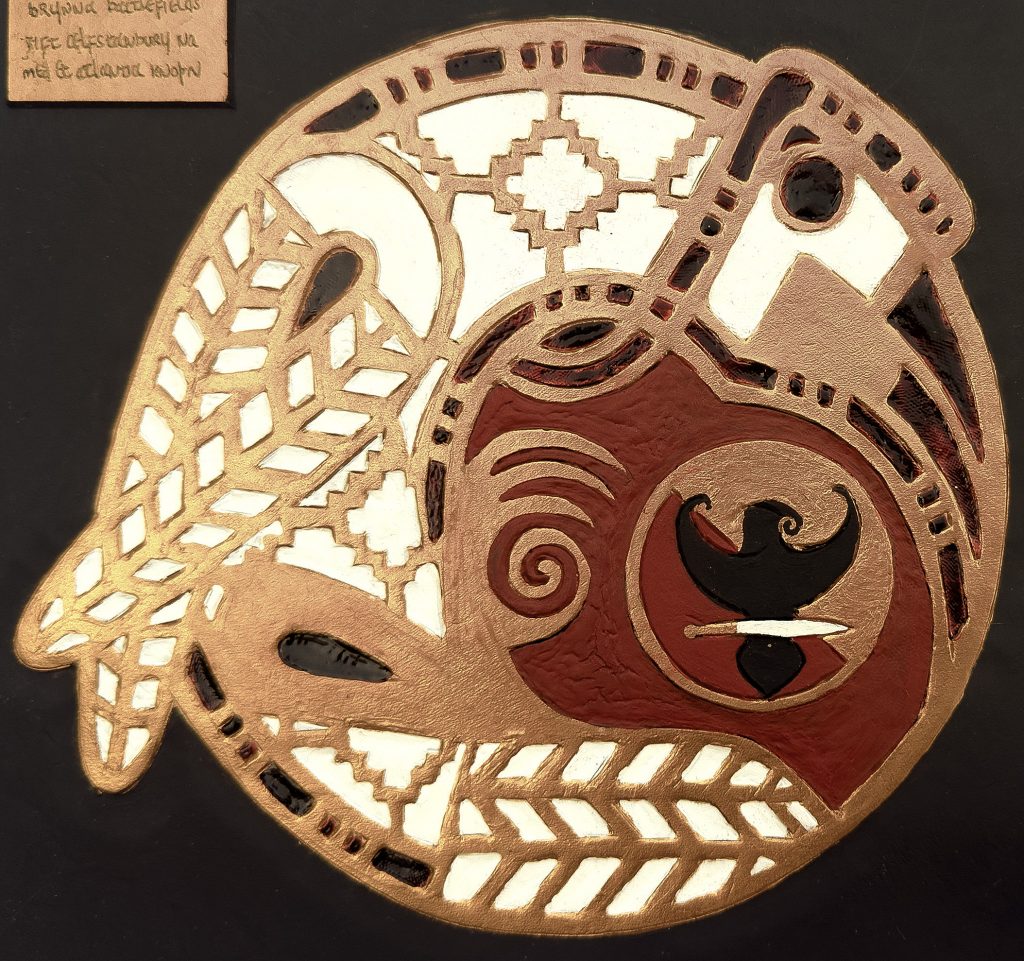
The head structure comes not only from the purse lid, but a such a broad number of early 7th century English metalwork finds that the structure becomes typological. These examples include—but are not limited to—a shield mount from the Sutton Hool burial (from which I also derived my claw), a pair of gold and garnet mounts from the Staffordshire Hoard, details tucked into the corners of the Sutton Hoo buckle (above), a pair of details tucked into the center of a mount showing two birds holding a fish, and even a gold filigree belt buckle. It could be said that an Early English bird requires this type of angled head structure.
bird heads
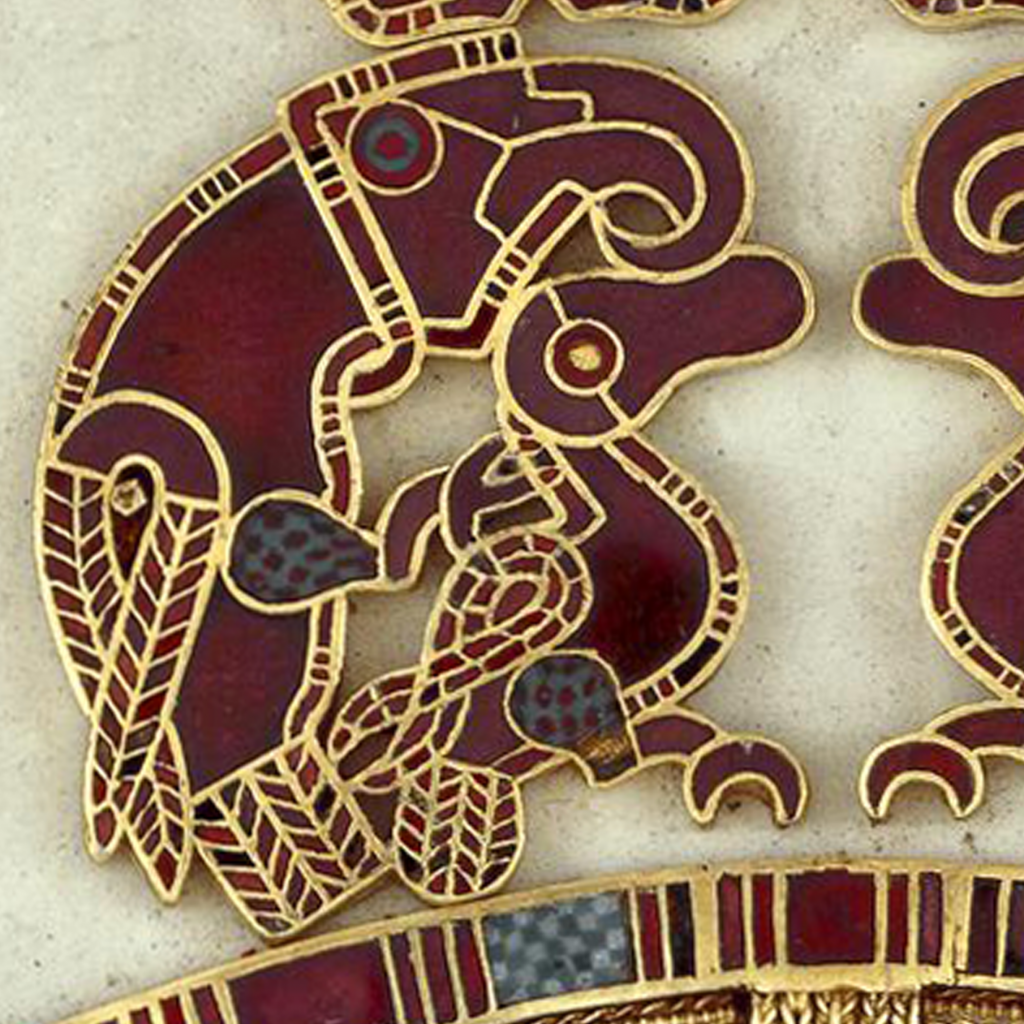
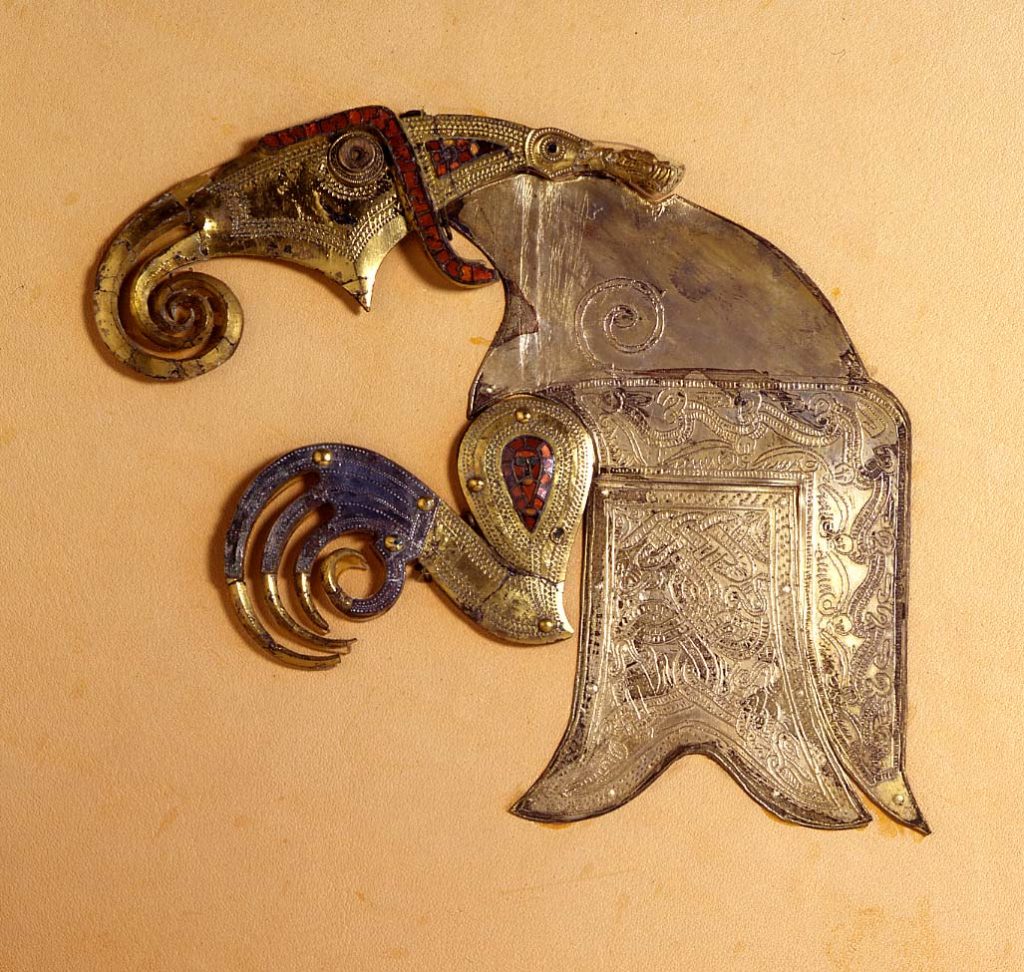
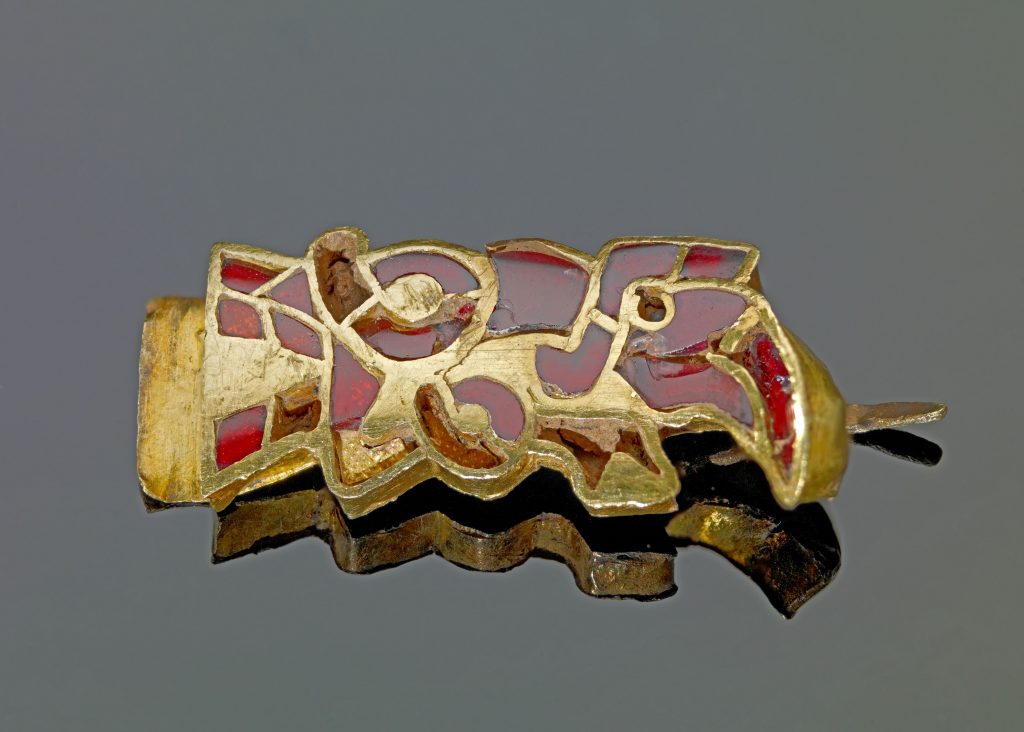
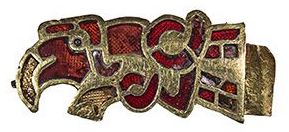
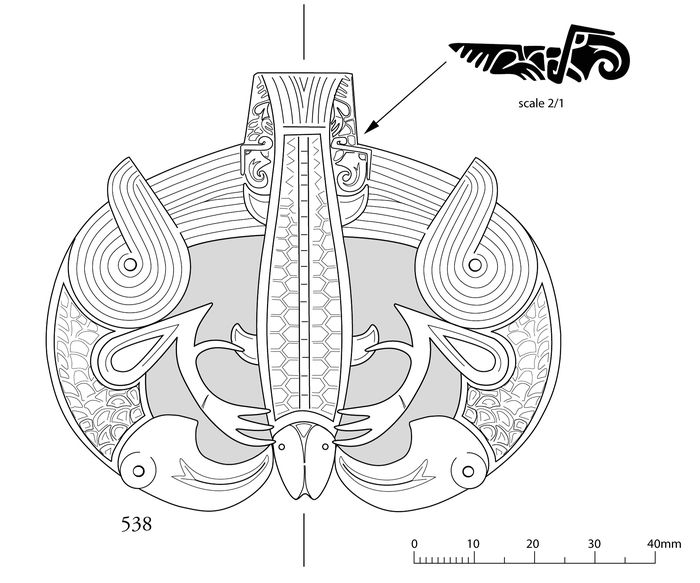
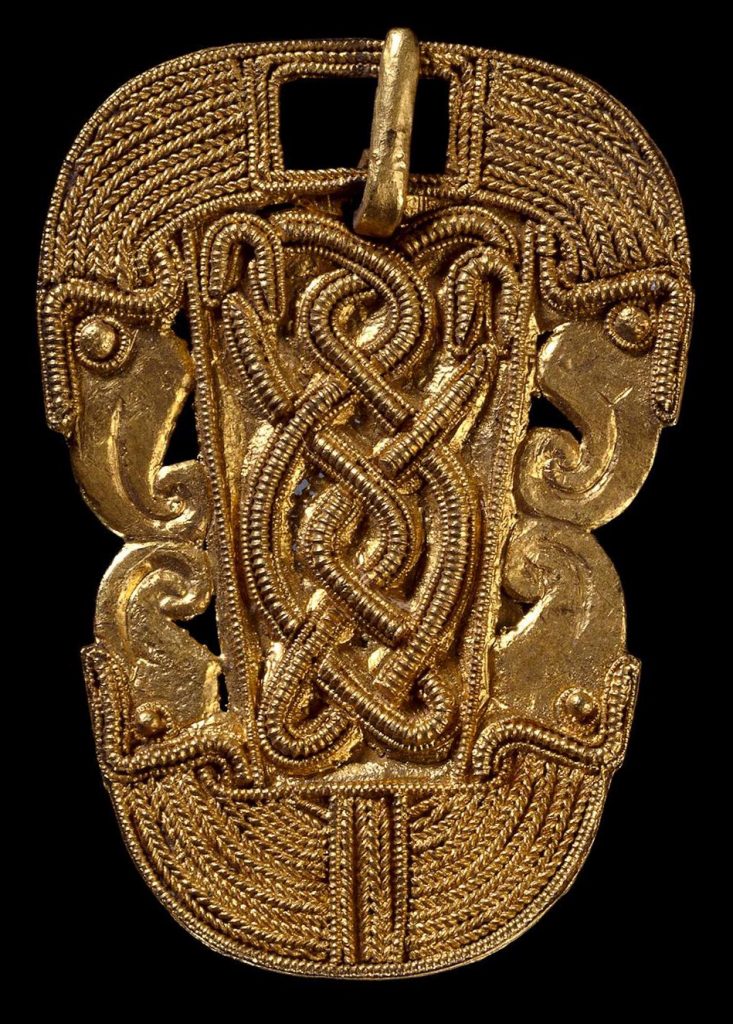
.1094.’70
6th–7th C
British Museum
A garnet cloisonné stepped lozenge design provided me a great example of a body fill. It comes from a late 6th C–early 7th C shoulder clasp5—an item which wonderfully illustrates the twin tenets of Early English metalwork I described above: riddles, and abstraction.
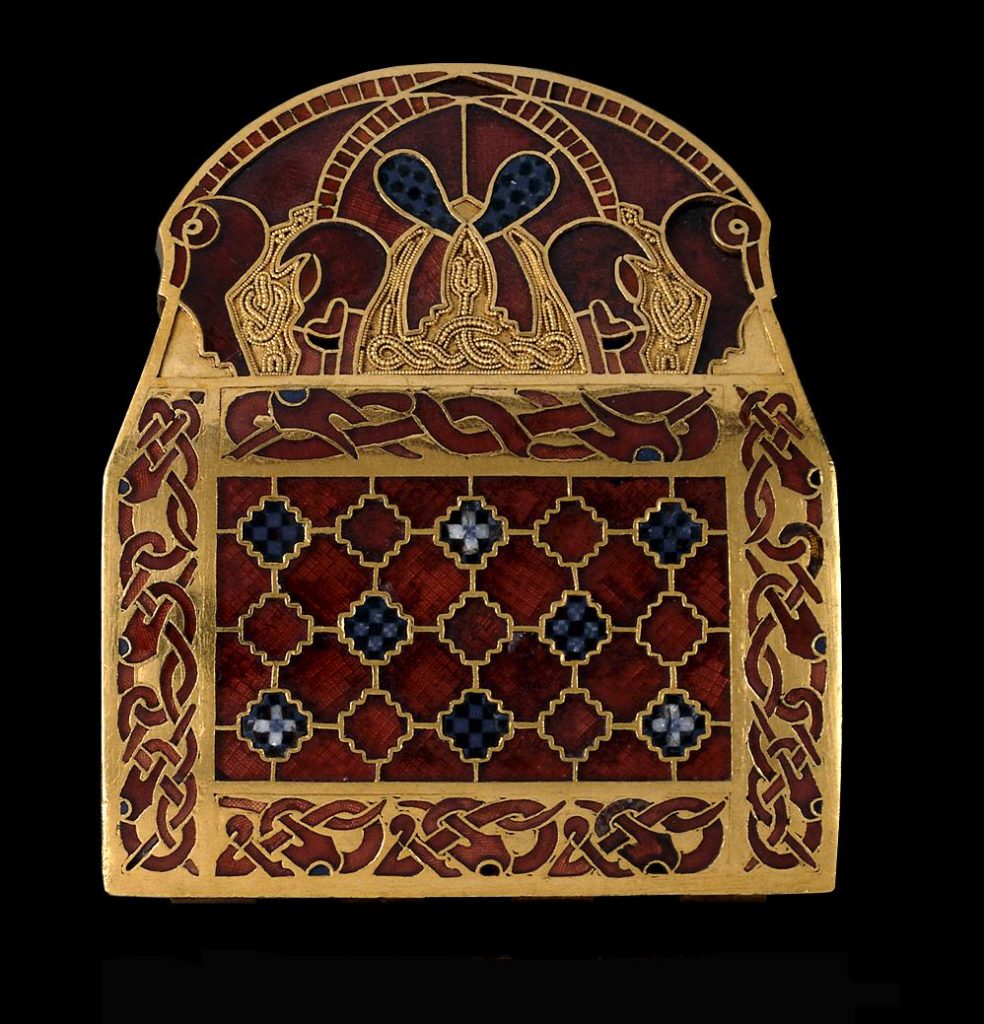
The shoulder clasp, another Sutton Hoo burial find, features two abstract, interlaced boars. At first glance, the effect of the interlaced bodies gives the impression of a milling group of animals, doubtless a familiar sight to the intended viewer, a scrum in which it would be difficult to tell how many individuals are crowded together. The only way to tell is to count the heads. The abstract nature of the animals adds to this riddle, since this playful confusion would be much harder with a realistic figure.
Our abstracted animal headcount continues with the beasts in the lower, rectagular frame, and the snake-like gold filigree fills around the boars’ legs.
Overall, this shoulder clasp is a wonderful thesis exploring the greats of Early English metalwork. It’s an exemplar of riddles and abstraction. It features zoomorphic beasts, interlace, and geometric, repeating fills. And it contains millefiori, alongside gold and garnet: the most popular materials/finishes in Early English metalwork6.
material culture
Millefiori is an early glasswork technique, an example of which is this domed cap from the Staffordshire Hoard. Featuring red, white, and blue glass surrounded by gold and garnet, it’s theorized that this piece attached to a second piece of the hoard, though it’s uncertain what the larger item is. (Note: over time, the red glass has darkened. It would originally have been brighter.7)
For me and this scroll, it affords a few more extant colors and transparencies. The gold and garnet combo is seen in a wide number of very early English finds, but other colors are more rare—and usually brought in with millefiori, as in this cap and the clasp above.
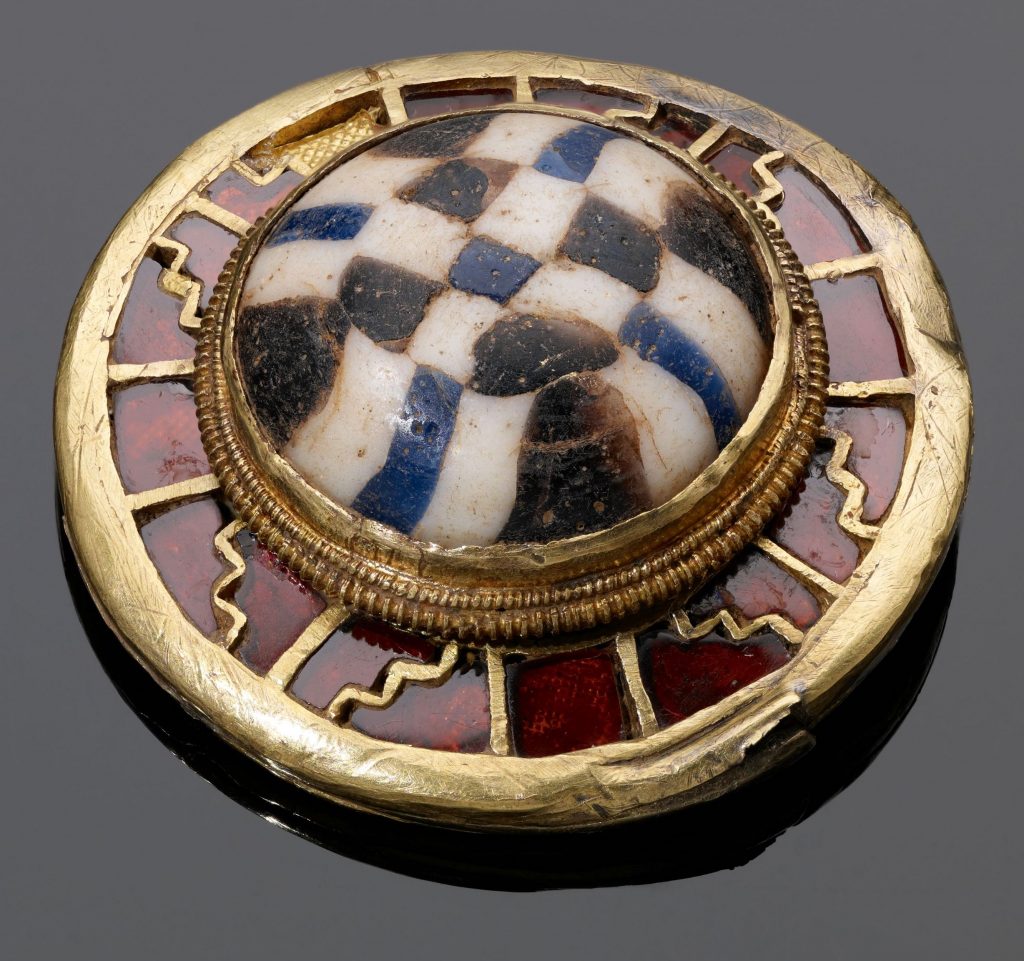
Which meant I had a limited extant palette to apply to my scroll. Fortunately, the heraldic pelican is white with yellow (gold) beak and feet, with blood red the only other required color, so I didn’t have to search far for what materials would logically have been used to create a pelican in this style; opaque white and red glass, transparent garnet, and gold were right there for the taking. And they were relatively simple to replicate in more accessible materials of paint and leather. (As mentioned above, one implication of remediation is improvement. For these purposes, this change of materials is an improvement, because not only do they allow the scroll to better serve its needs through increased visibility at court, but they allowed its creation in the first place.)
The translation into leather wouldn’t even effect one of the most characteristic features of Early English gold and garnet metalwork.
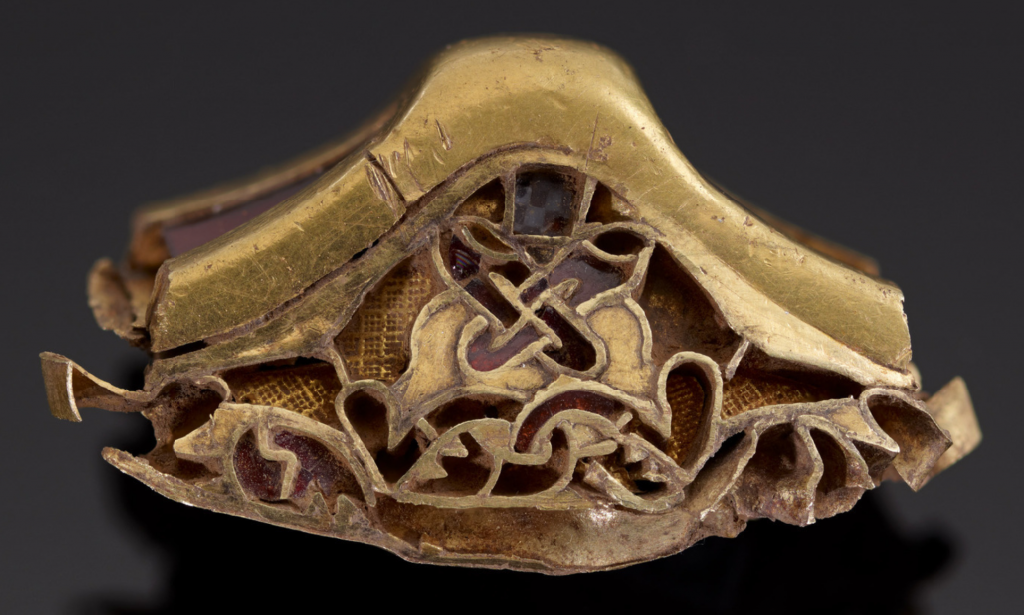
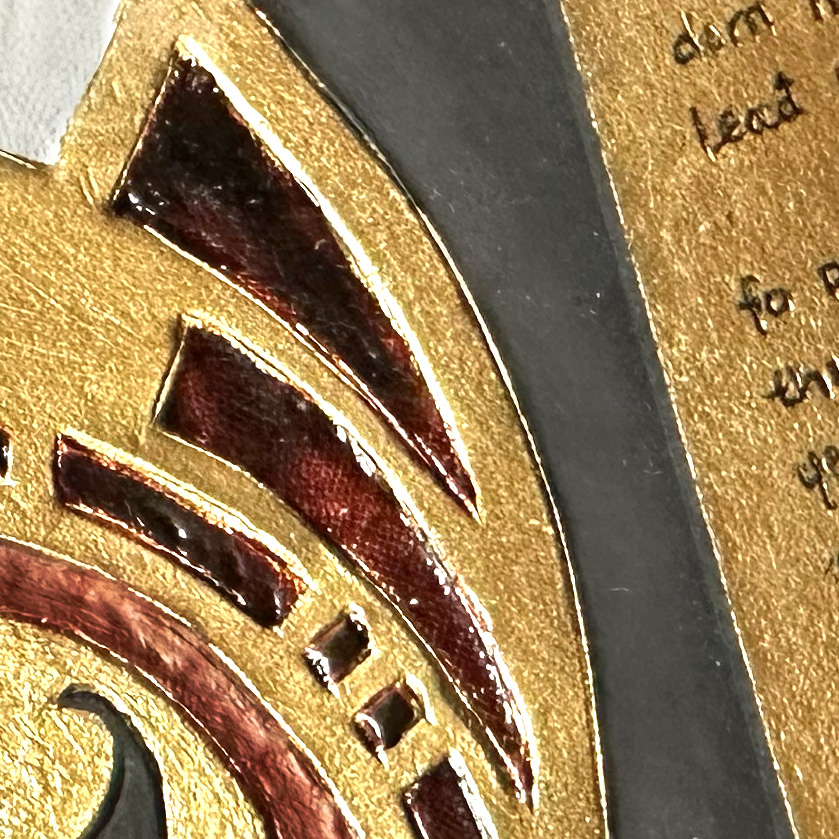
Back in about 2011, I was fortunate to see the Staffordshire Hoard in person. One enduring memory from that exhibition is where they highlighted how the texture of the gold foil underneath the garnets would scatter the light, and the importance of the technique both physically and as an art historical feature.
So when Korrin, Lanea, and I were collaborating on Valdimárr’s Kraken scroll, I remembered the importance of this technique to the success of gold and garnet work from Early English workshops. The stamped pattern reminded me of the knurling on the most common leatherwork stamps, and with that scroll—as in this one—that texture plays the same role. While in this instance it’s gold paint rather than gold foil, at certain angles the patterned light nevertheless passes through the transparent garnet glaze and reflects back through, giving the result a depth it would not have had with glaze alone. (Gold is always hard to photograph, and this scroll is no exception. In my opinion, the photograph doesn’t do it justice.)
At any rate, even though it’s made of different materials and at a different scale, the construction of this scroll not only makes use of the material innovation of the original works, but benefits from them, too.
WORDS, WORDS, WORDS
Hie near and hark well · for here We raise
Baroness Brynna · Battlefield’s Gift,
Ælfstanbury named · and Atlantia known!
With Morrigan’s might · the melee grows true
She sows safety. · Seeds a good bout.
This laudable list-maker · linen-writer,
oft has she ordered · an entangled field.
This benevolent bounty · a bird is worth.
Now shall her shield · shine alone with
raven rising · on red field and gold,
bearing a blade both · bright and keen
honed to help. · And here a cap
peerlike plumage · a Pelican’s due,
weighty with warrant-lore · wisdom heavy,
but light with laughter · to lead her work.
So ring bells of Brynna, bold and clarion,
this fifteenth of Iunius · the fifty-nineth year
As our King called Christoph · and Queen Adelheit
sing songs of her service, speak of her deeds,
elevate her action · and honor her name.
a new song
Although it is a poetic form whose basis in oral tradition continues to be debated, in practice the rhythm and meter of spoken Old English poetry has a visceral power I couldn’t ignore8. If I wanted to make this elevation text special, I wanted someone to be able to proclaim it.
But I couldn’t guarantee an Old English reader would be there, and didn’t want to encumber an unsuspecting and hardworking herald with the task, so I decided the best plan would be to write a poem in Modern English packed with the sensory experience of Old English. The mouthfeel. The beat in head and heart. I wanted the sound of the announcement to call attention just as much as a “hwaet!”, and I wanted the sound of its message to please ears and warm hearts.
To this end, I made sure to integrate Old English styles of phraseology, meter, stress, repetition, and humor9. I didn’t do this in a piecemeal manner of stripping leaves from original branches and placing them in a new form, but instead I refreshed my longstanding familiarity of the corpus until the beat rang in my head, and sang new lines and half lines to myself until the entire new poem was complete.
There are certainly quicker ways of writing poetry. But I don’t claim to be a poet, and this is mine.
“Have you heard, sailor, what these people say?”
-The Battle of Maldon
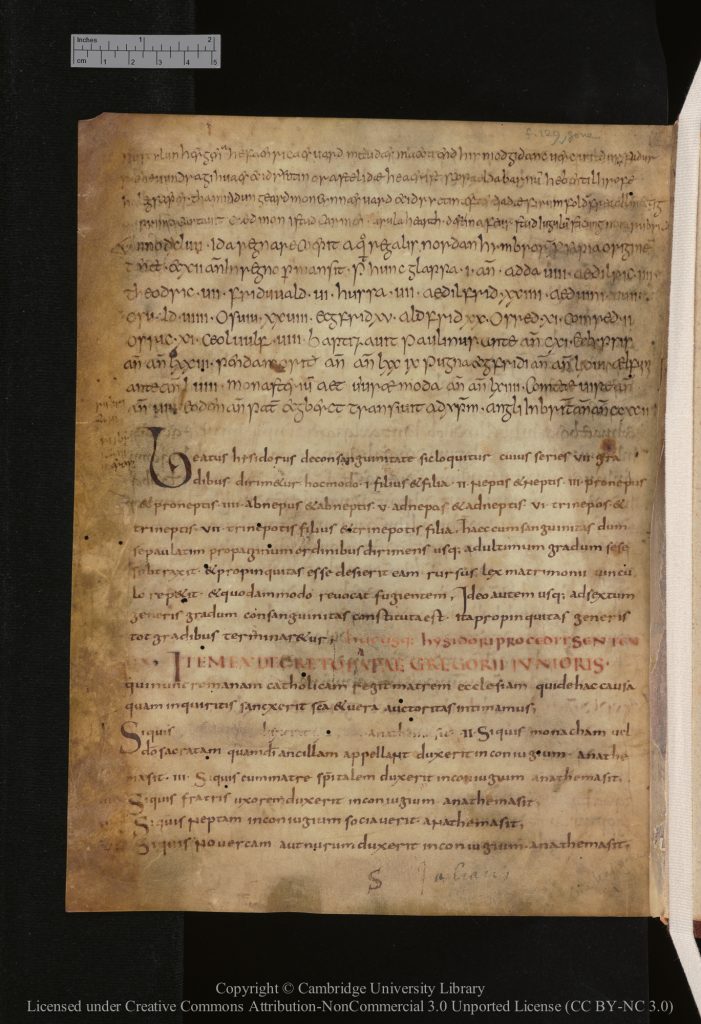
I filled my head with a useful range of verse, starting with Cædmon’s Hymn10.
Cædmon’s Hymn is our earliest extant Old English poem, possibly composed between 658 and 680 CE. All extant versions are found among 21 copies of Bede’s Historia Ecclesiastica Gentis Anglorum, with slight textual variations across them. It’s not a hymn in the current meaning, but nevertheless it has the useful tenor of a praise poem, which set up my mind for the sort of feeling I wanted to establish with Brynna’s verse.
But I didn’t want the Hymn to be my only reference, so it was also useful to know that it follows the same framework as the Old English poetry spanning the next three or four centuries11. This knowledge allowed me to comfortably consider a wide range of extant poems in guiding my verse without fear I was mixing meters (so to speak).
Since the Pelican is a service award, it might seem more logical to have pulled from one of the less martial pieces, like one of the Elegies. But Brynna has spent a lot of her effort in service to the lists, and her heraldry bears a raven and a sword, so I felt that conjuring the battlefield with my language made a lot of sense. Both dating to the 10th/11th century, I found the Battle of Maldon12 and Beowulf13 helpful for this. The line above is from the former, and it perfectly captures the sense of invocation I wanted for this piece, as well as conjuring the connection of individual to community (and vice versa). An integral part of service is the tie between server and populace, so it made sense to set the latter as a viewpoint character in the verse alongside the royalty. We, the group, are championing her elevation.
Riddles aren’t just popular in Early English visual art; it a characteristc of their poetry, too. (You might say it’s riddled with it.) “List-maker” has a double meaning. It could refer to the list field, or it could also refer to the reasonable assumption that service and organizing requires thorough planning. Requires lists. I was told that Brynna is also an artisan with a needle and thread, and so we have “linen-writer”. An “entangled field” could ambiguously refer to either the lists or her art.
The twists and constraints of Old English meter are exceedingly fun to navigate, but they also require flexibility. The SCA has a number of traditions which were formed when its focus was firmly in the European High Middle Ages, and these conventions aren’t easily transferred when the persona comes from outside those bounds. Heraldry is a big example of this. In our current example, my words had to fit within the Old English alliterative meter while still conveying relevant information. Traditional blazon doesn’t fit; in fact, it would throw us out of the magic the SCA strives for. Instead, I tried to conjure the accurate spell with appropriate language within the poetical framework, and so get the job done within the constraints of the form. (There is significant precedence for this. I am grateful for those in the past who have also recognized the need for flexibility in the embrace of a diverse range of personae.)
strip mining
The words on the scroll also needed to support the visual thesis of migration-style artwork. So parchment wouldn’t fly. (Bird pun.)
Unlike the Sutton Hoo burial, the Staffordshire Hoard looks to have been broken or misshapen before being discarded14. One of the mistreated items was a bent strip of metal, which reveals upon examination its importance. To history, to archaeology, to art history, and to us, here.
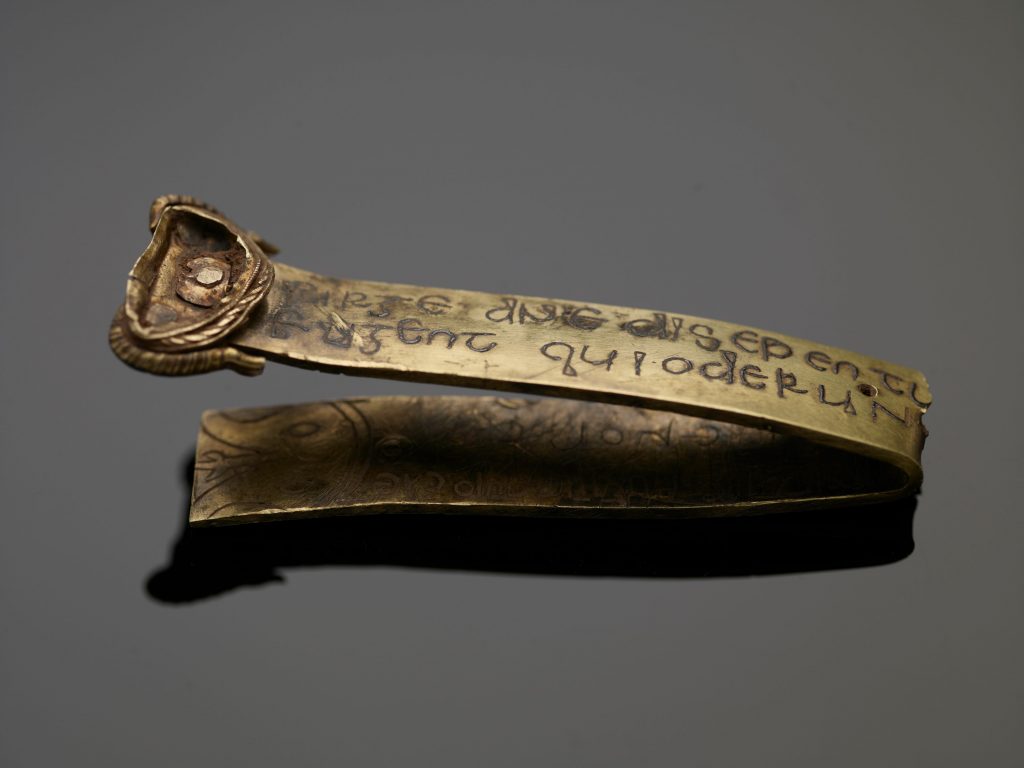
The strip is one of the few non-martial items in the Hoard, “believed to have originally been part of a cross15.” Made from gold-covered metal, perhaps silver (they were unable to pin in down more specifically in the lab through nondestructive testing16), it bears writing on both sides. Scribed into the end is a snake’s head, and the front bears a D-shaped fitting for a gemstone, now lost. The engraving has been inlaid with niello—a metallic alloy containing sulphur—to make the letters stand out more clearly.
The text contains two different versions from two different hands of the same inscription from Numbers. Each version has similar text, but not identical. Even the abbreviations varied. The line is both a curse and an invocation for backup: “Arise, O Lord, and may your enemies be torn apart and those who hate you will flee from your face17.”
The letterforms bear a strong relationship to that of the Phase 1 Insular half-uncial of the Cathach of Columcille18, with a few adaptations. Insular half-uncial is a higher grade than minuscule, and less the the more important majuscule/uncial19. Judging my the typical way scribes illustrated importance and weight through the use of certain levels of script, this suggests to me that both scribes placed a particular importance on this text. This is no quick note scrawled off in a quick, cursive-like minuscule. This was a script with compelling and resonant weight. The script was repeated by two scribes, and the one presumably deemed correct was inlaid with niello to make it final.
Writing on gold to compel your text to the deities is an ancient practice which spans huge swathes of the globe, largely (but not entirely) overlapping with the spread of the Roman Empire20. The strip in the Staffordshire Hoard indicates that this practice didn’t leave the islands when the Roman management did; the two scribes took time with their inscriptions, choosing a higher grade script than the Insular minuscule used at the time for quicker, more perfunctory writing, or even the Early English minuscule that would be used for the Beowulf manuscript four centuries later. According to Michelle Brown, the manner of the writing, its lack of dexterity, suggests that it may have been the work of someone more used to writing on wax tablets21. However, one of them bothered to replicate a few of the ink-and-pen serifs within the limited form. They wouldn’t have done this if the inscription didn’t matter.
D. G. Charles-Edwards goes deeply into this interplay of stylus and pen with letterforms in his (fascinating—to me anyway) 2000 thesis22, and delving further might reveal even more in future.
The outlined treatment of the serifs on the outer side seems to indicate a scribe who was deeply aware of how the letterforms would have been shaped by ink on parchment, and the adaptations to the usual Insular half-uncial letterforms indicate someone who wanted to represent serifs in a monoline scenario, because they were an inherent feature of the script. Given the awareness of Insular scribes at this time that script hierarchies imply a greater or lesser holiness, alongside the possibility of the verse’s use for apotropaic purposes23, I posit that the addition of serifs could signal the scribe’s hope for a better result.
layout
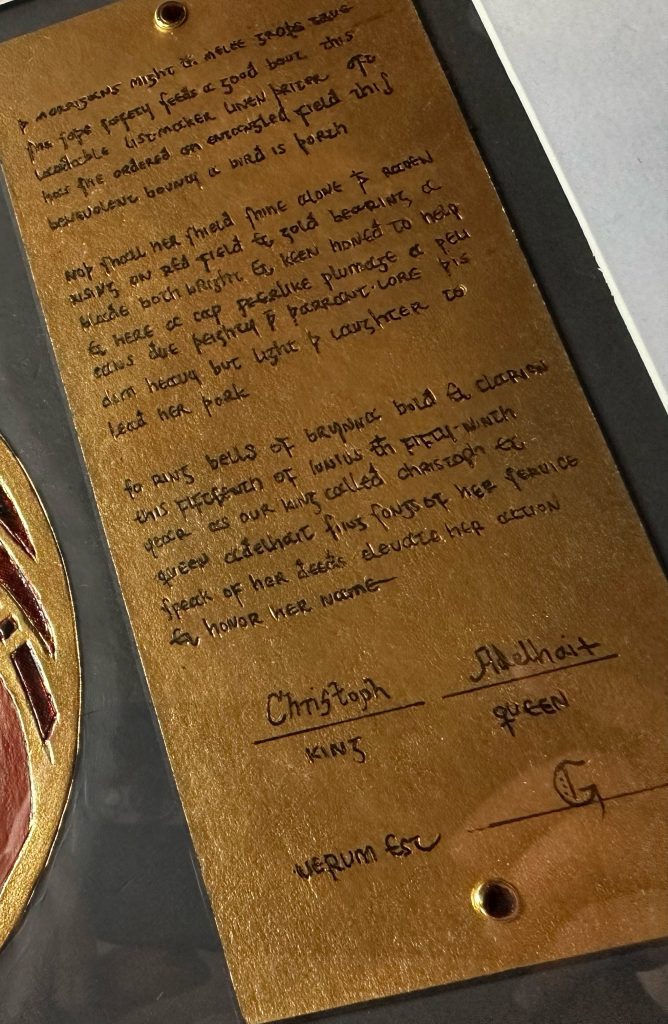
When I needed to display the text, I started from the script. But given that the text length was longer than a line, I needed to decide how to best to present it across a larger area.
Unlike modern typesetting conventions, Old English verse stretches across the page with little and sporadic indication as to its structure24. As such, when I decided to turn the strip into a plaque, which would provide me ample room for text while keeping within the paradigm of a museum scroll, I filled the space with text. When I left spaces, they were for times when both semantic (meaning) and practical (breathing) pauses overlapped. O’Keeffe’s work with the development of text and layout over time neatly implies the validity of this tactic.
The text was both inked and inscribed, as an attempt to replicate the inlaid niello of the original strip. Without the ink the letters disappeared, and without the inscription the letters looked flat.
When all the lettering was done, that still left me with the problem of how to attach the plaques to the substrate. The original strip features a D-shaped setting for a gemstone, but that was hardly a practical solution. For one thing, I needed three attachment points. For another, I’m not a jeweller.
rivets
I found my solution(s) in this early 7th century brooch, commonly called the Sarre Brooch, found in Kent. One is of the four gems is missing, but the remaining three provide perfect examples—properly-scaled in terms of both size and physical possibility.
The catalogue text describes these features as, “a cabochon garnet in a tubular gold setting”, but my facsimile involved the same translucent garnet-colored glaze with which I created the main design, added to brass rivets. I think the result looks accurate enough and gets the job done.
As an aside, the color combinations of this piece provide further substantiation to my design decisions. While the white in this piece comes from shell, and the white I created was intended to replicate glass, the gold/garnet/white immediate says early 7th century English material culture. (And please note the empty cells at about 9:00, with the stamped pattern revealed by the missing garnets. Those are pretty characteristic, too.)
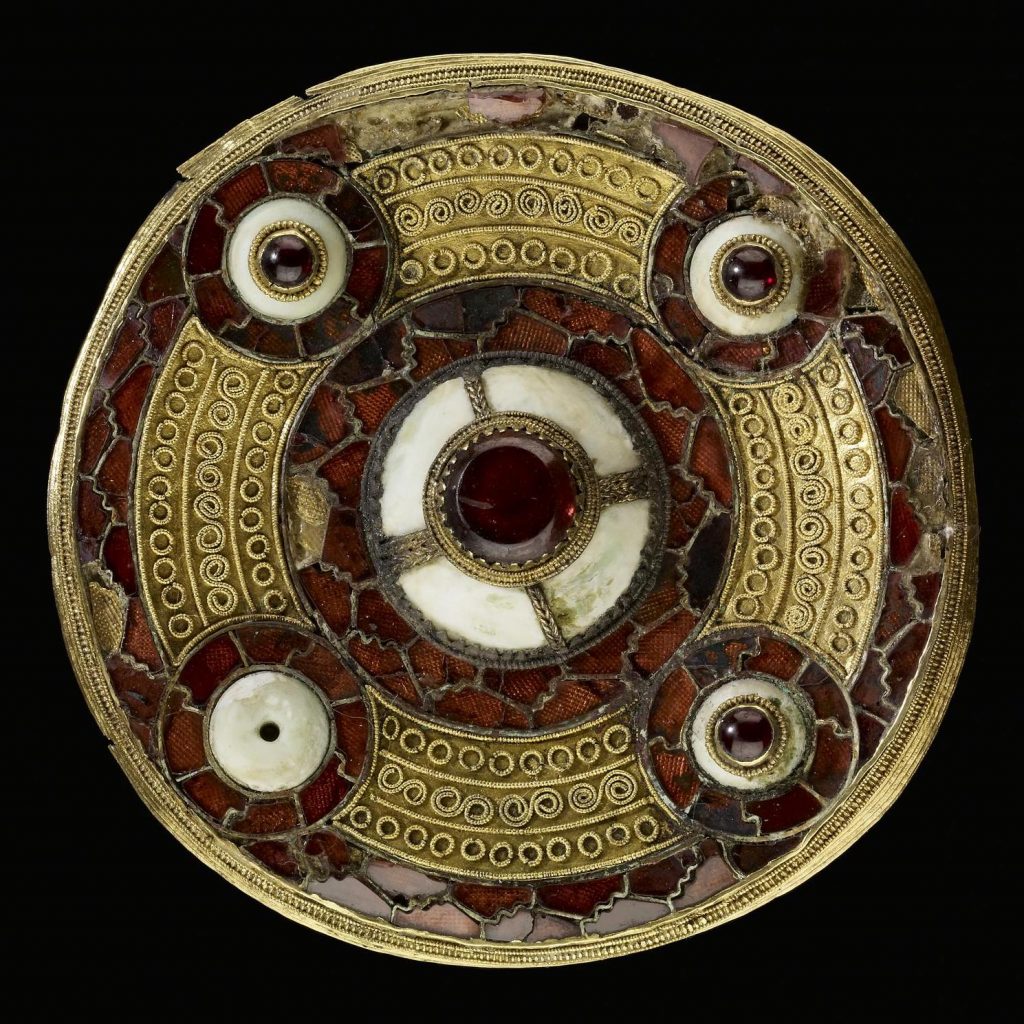
TO WRAP UP
I also hope I’ve demonstrated the benefit of applying art historical research to art practice.
When we have art historical knowledge, we have better contextual information about the art we’re looking at. And better context means we can more fluidly, accurately, and dexterously adapt historical art to our present needs.
With art historical knowledge in my pocket, I was aware how the art of this period related to the art of those later periods so central to the SCA. And that meant I had the resources to best curate artifacts and translate the design so the needs of the past align with the needs of the present, and the goals of the scroll are (joyously) met.
Not only did I have academic research to help me make accurate choices, but research helped me identify options and create a result that was so much better than it would have been without it.
Art history helped me tell a better story.
Thank you to Etienne for the opportunity to dive into late 6th–early 7th CE English material culture and transform it into a practical (and, hopefully, beautiful) award.
Congratulations, Brynna! I can’t wait to meet you.
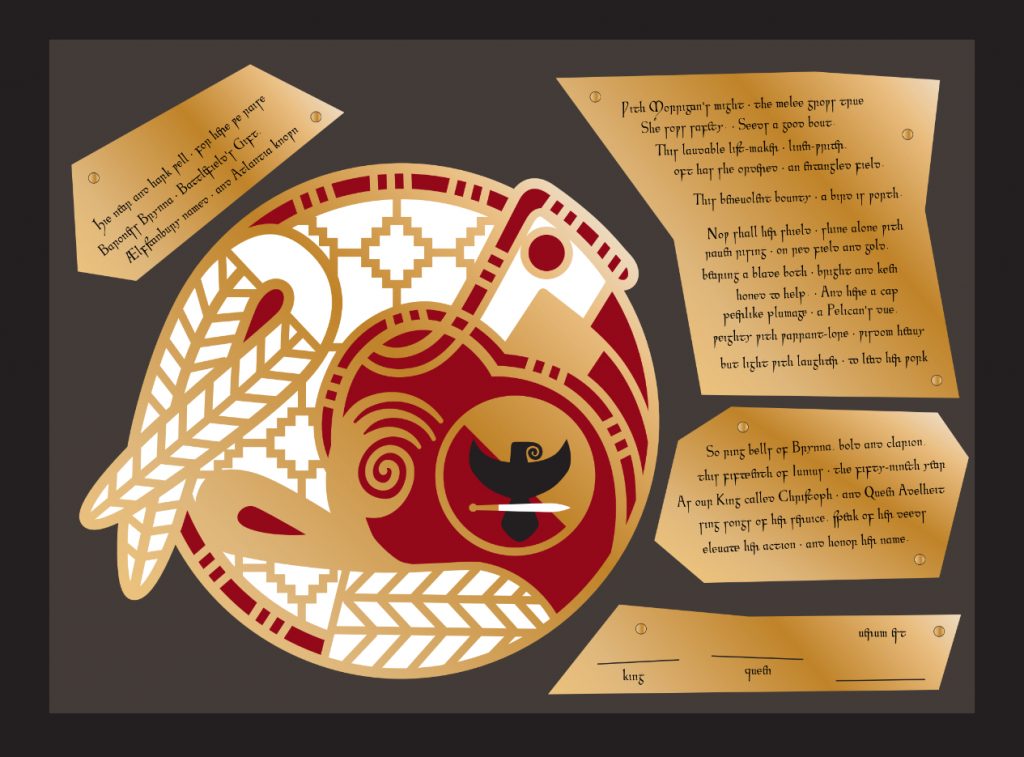
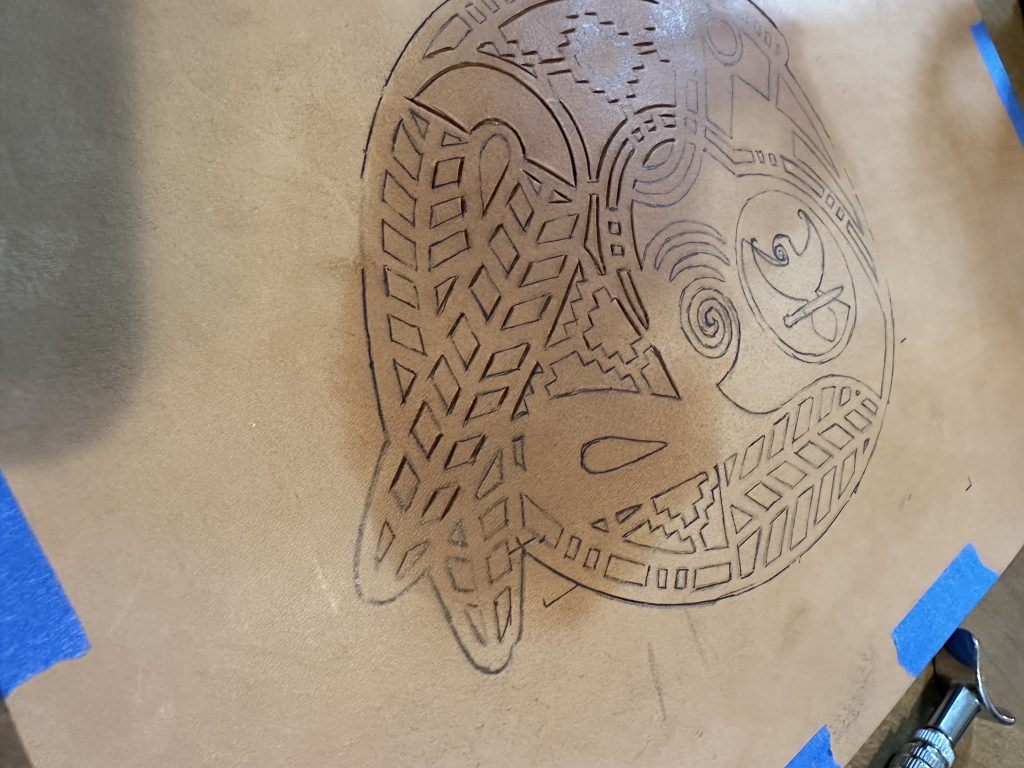
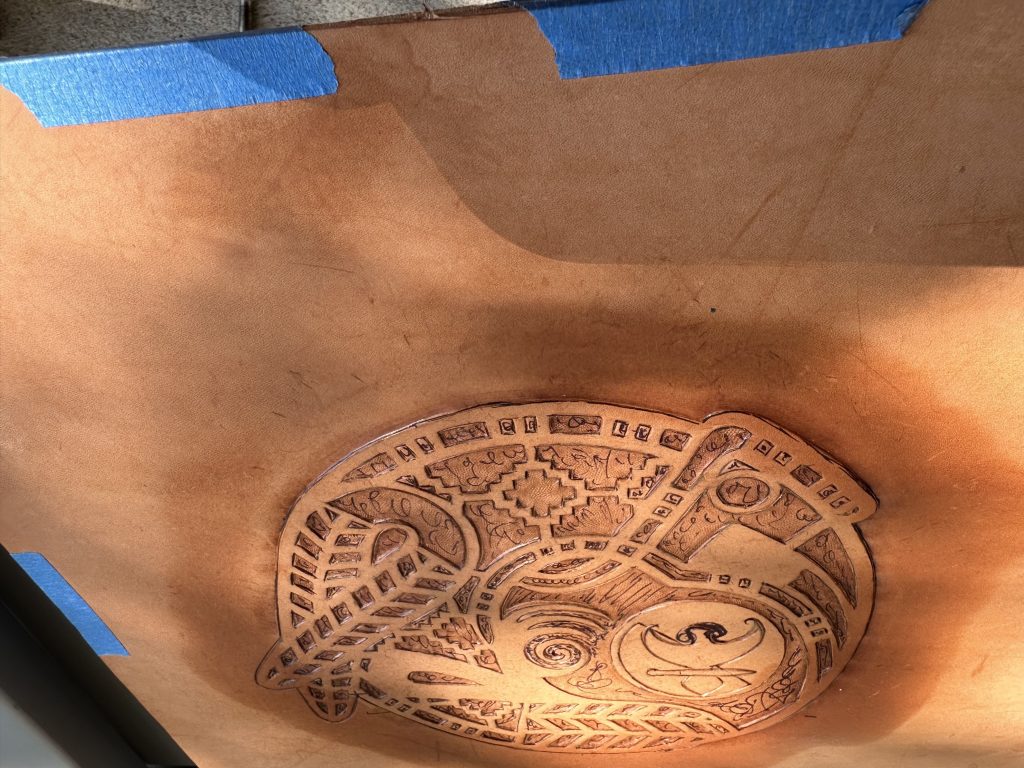
NOTES
- Jay David Bolter and Richard Grusin, Remediation: Understanding New Media (Cambridge, MA: The MIT Press, 2000), 59. ↩︎
- Bernhard Salin. “Die altgermanische Thierornamentik. Typologische Studie über germanische Metallgegenstände aus dem IV. bis IX: Jahrhundert, nebst einer Studie über die irische Ornamentik” (Stockholm 1904), 245-70. ↩︎
- Michelle Brown, Art of the Islands – Celtic, Pictish, Anglo-Saxon and Viking Visual Culture (The Bodleian Library, 2016), 27. ↩︎
- Sutton Hoo Purse. British Museum. https://www.britishmuseum.org/collection/object/H_1939-1010-2-a-l ↩︎
- Shoulder clasp. British Museum. https://www.britishmuseum.org/collection/object/H_1939-1010-4-a ↩︎
- Catherine E. Karkov. The Art of Anglo-Saxon England (Woodbridge, Suffolk: Boydell Press, 2011) 99. ↩︎
- https://web.archive.org/web/20211207055451/http://www.staffordshirehoard.org.uk/explore-the-hoard/millefiori-stud#1 ↩︎
- Francis P. Magoun, “The Oral-Formulaic Character of Anglo-Saxon Narrative Poetry.” Speculum 28 (1953): 446–67 ↩︎
- I studied Old English at university back in the late 90s. It’s been a while, but it sticks with you. Since then, my professor has published an accessible textbook I invite you to explore: Robert J. Hasenfratz, and Thomas Jambeck. Reading Old English : A Primer and First Reader Rev. ed. (West Virginia: WVU Press, 2011). ↩︎
- “”Cædmon’s Hymn”: the Seven West Saxon Versions” https://uw.digitalmappa.org/12. ↩︎
- “All Old English poetry is of such uniformity in form and language that it is impossible to establish even relative dating with any certainty.” Malcolm Godden and Michael Lapidge, The Cambridge Companion to Old English Literature, 1st ed (Cambridge [England]: Cambridge University Press, 1991) 57. ↩︎
- “Battle of Maldon | Old English Poetry Project | Rutgers University”, https://oldenglishpoetry.camden.rutgers.edu/battle-of-maldon/. ↩︎
- “Beowulf | Old English Poetry Project | Rutgers University”, https://oldenglishpoetry.camden.rutgers.edu/beowulf/. ↩︎
- Caroline Alexander and National Geographic Society (U.S.), Lost Gold of the Dark Ages : War, Treasure, and the Mystery of the Saxons (Washington, D.C.: National Geographic Society, 2011) 89. ↩︎
- Brown, Lost. 12. ↩︎
- Barbican Research Associates (2019) The Staffordshire Hoard: an Anglo-Saxon Treasure [data-set]. York: Archaeology Data Service [distributor] https://doi.org/10.5284/1041576 [strip: cat no 540] ↩︎
- C. Breay and J. Story, Anglo-Saxon Kingdoms: Art, Word, War (British Library, 2018) 88. ↩︎
- Michelle P. Brown. “Southumbrian Book Culture: The Interface Between Insular and Anglo-Saxon.” In C. Hourihane, ed., Insular and Anglo-Saxon Art (Princeton University Press, 2011) 22. ↩︎
- D. G. Charles-Edwards, “The Epigraphy of Wales 550–1000 Examined in a Wider Insular Context: The Interchange Between Written and Inscribed Letters,” M.Phil. thesis, (University of Wales College, Newport, 2000) 24, 40. ↩︎
- Roy D. Kotansky, “Textual Amulets and Writing Traditions in the Ancient World,” in Guide to the Study of Ancient Magic (Brill, 2019) 507–508. ↩︎
- https://web.archive.org/web/20120709214529/http://www.staffordshirehoard.org.uk/staritems/the-biblical-inscription ↩︎
- Charles-Edwards, “Epigraphy”. ↩︎
- Brown, Lost. 122. ↩︎
- Katherine O’Brien O’Keeffe, “Orality and the Developing Text of Caedmon’s Hymn,” Speculum 62, no. 1 (1987): 1, https://doi.org/10.2307/2852564. ↩︎
FURTHER READING
Alexander, Caroline, and National Geographic Society (U.S.). Lost Gold of the Dark Ages : War, Treasure, and the Mystery of the Saxons. Washington, D.C: National Geographic Society. 2011.
Breay, C., and J. Story. Anglo-Saxon Kingdoms: Art, Word, War. British Library, 2018.
Brown, Michelle. Art of the Islands – Celtic, Pictish, Anglo-Saxon and Viking Visual Culture. The Bodleian Library, 2016.
Charles-Edwards, D. G. “The Epigraphy of Wales 550–1000 Examined in a Wider Insular Context: The Interchange Between Written and Inscribed Letters,” 2000, https://pure.southwales.ac.uk/ws/portalfiles/portal/2145103/D._G._Charles_Edwards_2000_1802924.pdf.
Fulk, R. D. “Old English Meter and Oral Tradition: Three Issues Bearing on Poetic Chronology.” The Journal of English and Germanic Philology 106, no. 3 (2007).
Godden, Malcolm, and Michael Lapidge. The Cambridge Companion to Old English Literature. 1st ed. Cambridge England: Cambridge University Press. 1991.
Hasenfratz, Robert J, and Thomas Jambeck. Reading Old English : A Primer and First Reader Rev. ed. West Virginia: WVU Press. 2011.
Hourihane, C ed. Insular and Anglo-Saxon Art. Princeton University Press, 2011
Karkov, Catherine E. The Art of Anglo-Saxon England. Woodbridge, Suffolk: Boydell Press, 2011.
Kotansky, Roy D. “Textual Amulets and Writing Traditions in the Ancient World.” In Guide to the Study of Ancient Magic, 507–54. Brill, 2019. https://doi.org/10.1163/9789004390751_020.
Magoun, Francis P. “Oral-Formulaic Character of Anglo-Saxon Narrative Poetry.” Speculum 28, no. 3 (July 1953): 446–67. https://doi.org/10.2307/2847021.
O’Keeffe, Katherine O’Brien (January 1987). “Orality and the Developing Text of Caedmon’s Hymn”. Speculum. 62 (1): 1–20. doi:10.2307/2852564. JSTOR 2852564. S2CID 161081164.
Pascual, Rafael J. “Oral Tradition and the History of English Alliterative Verse.” Studia Neophilologica 89, no. 2 (July 3, 2017): 250–60. https://doi.org/10.1080/00393274.2017.1369360.
Salin, Bernhard “Die altgermanische Thierornamentik. Typologische Studie über germanische Metallgegenstände aus dem IV. bis IX: Jahrhundert, nebst einer Studie über die irische Ornamentik” (Stockholm 1904) 245-70.
Wamers, Egon. “Behind Animals, Plants and Interlace: Salin’s Style II on Christian Objects.” In Anglo-Saxon/Irish Relations before the Vikings, edited by James Graham-Campbell and Michael Ryan, 0. British Academy, 2009. https://doi.org/10.5871/bacad/9780197264508.003.0008.

